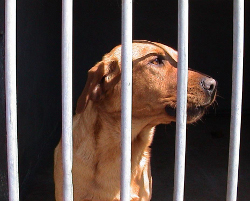Crate Training an Older Dog
 Crate training an older dog is just like all attempts to teach an older dogs to do things - harder, but not really different, than with puppies. The key is understanding the fact that an older dog is set in their ways. Unlike a puppy, who can basically be shaped a certain way, you have to change an older dog's mind.
Crate training an older dog is just like all attempts to teach an older dogs to do things - harder, but not really different, than with puppies. The key is understanding the fact that an older dog is set in their ways. Unlike a puppy, who can basically be shaped a certain way, you have to change an older dog's mind. No matter what your reasons are for wanting to crate train an older dog, it's a good idea. Crates (and kennels, if your dog stays outside), represent a place of security, comfort, and relaxation to your dog when they're properly trained.
They will actually look forward to going inside on their own! So how do you teach an older dog to look forward to going into their crate?
With rewards, of course! Crate training older dogs is a lot easier when you realize that the same principles of training are true. Make the crate seem like an attractive place to be, and the dog will naturally want to go there.
Use the crate as a tool for punishment, and your dog will think they have done something wrong every time you tell them to go inside!
The first thing that you have to ask yourself is whether or not your dog has a favorite toy or two. If they do, then you simply need to put their toys in the crate. Get them used to going inside and getting their toys.
Every once in a while, put their toys inside and close the door to the crate. When your dog sees the toys behind the door, they will start to yearn to go inside. They might even whine or paw at the door. At this point, they associate the inside of the crate with a place that want to be in.
If you put treats on the inside of the crate, it will work the same way!
You see, crate training an older dog is exactly like it is with a puppy. As long as your dog feels like they have made the choice to go inside, they will grow to love it. If you try to force it on them, it will only push it away.
One special consideration you have to keep in mind with older dogs is that they need extra bedding to be comfortable. Since they're older, they'll be a lot more comfortable sleeping in their crate and staying inside if you make it as soft as possible for them.
This will encourage your older dog to go inside and sleep on their own.
Dogs are smart and are very good at finding the most comfortable place to sleep. If you make the crate nice and comfortable, they'll naturally go to it. They're really training themselves at this point!
Crate training an older dog is a lot easier at night than it is with puppies because they don't have to potty every couple of hours. An older dog can easily hold it in for the whole night, so you shouldn't have to worry about letting them outside through the night.
Still, you need to make sure that you don't feed them and give them water too late at night. They'll be a lot more comfortable if you do it many hours before that. They might try to bark and whine during the night at first.
However, just like with puppies, you need to show your older dog that barking and whining will not get them out of their crate. The sooner that you can teach them this, the better.
Overall, you'll find that crate training an older dog is not too challenging. If you have ever done it with a puppy before, you'll have all the practice and experience that you need. As long as you don't force your dog inside and make sure to help them discover it on their own, they'll appreciate the new space.
Keep in mind that kennel training an older dog is really no different. You just need to make the kennel seem like an attractive place to be and never use it as a punishment (something that a lot of dog owners mistakenly do). Treats and toys work wonders, no matter what the age of your dog is. Use that to your advantage like you would with anything else, and you'll see really impressive results!
Go Back to Crate Training
Go Back Home to Dog Training